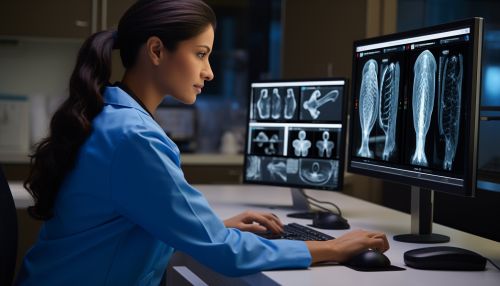Medical Image Analysis
Introduction
Medical Image Analysis is a branch of biomedical engineering and computer science that focuses on the interpretation of medical images for clinical diagnosis and research. It involves the application of computational and mathematical techniques to analyze and interpret medical images for the purpose of improving health care.
Types of Medical Imaging
There are several types of medical imaging techniques used in the field of medical image analysis. These include:
- Computed tomography (CT): This technique uses a series of X-ray measurements taken from different angles to produce cross-sectional images of the body.
- Magnetic resonance imaging (MRI): This technique uses a magnetic field and radio waves to create detailed images of the organs and tissues within the body.
- Ultrasound imaging: This technique uses high-frequency sound waves to produce images of the inside of the body.
- Positron emission tomography (PET): This technique uses a radioactive substance to create three-dimensional color images of the functional processes within the human body.
- Optical imaging: This technique uses light to capture images of the body, often used in research and preclinical imaging.


Image Acquisition
The process of acquiring medical images involves capturing the internal structures of the body using one of the aforementioned imaging techniques. The quality of the acquired images is crucial for accurate analysis and interpretation. Factors that can affect image quality include the imaging technique used, the equipment settings, patient movement, and the presence of artifacts.
Image Processing
Once the medical images have been acquired, they undergo a process of image processing. This involves enhancing the image quality and extracting useful information for analysis. Image processing techniques in medical image analysis can include noise reduction, contrast enhancement, edge detection, segmentation, and registration.
Image Analysis and Interpretation
The analysis and interpretation of medical images is a critical step in the diagnostic process. This involves identifying and quantifying features of interest in the images, such as the size, shape, and texture of a tumor. Advanced techniques such as machine learning and artificial intelligence are increasingly being used in medical image analysis to aid in the detection and diagnosis of diseases.
Applications
Medical image analysis has a wide range of applications in healthcare and research. These include:
- Disease diagnosis and monitoring: Medical image analysis is used to detect and diagnose diseases, as well as monitor disease progression and response to treatment.
- Surgical planning and guidance: Medical images are used to plan surgeries and guide surgeons during procedures.
- Research: Medical image analysis is used in research to study the structure and function of the body, and to develop new imaging techniques and analysis methods.
Future Directions
The field of medical image analysis is rapidly evolving, with advances in technology and computational methods driving progress. Future directions in the field include the development of more advanced image analysis algorithms, the integration of artificial intelligence and machine learning techniques, and the application of medical image analysis in personalized medicine.
